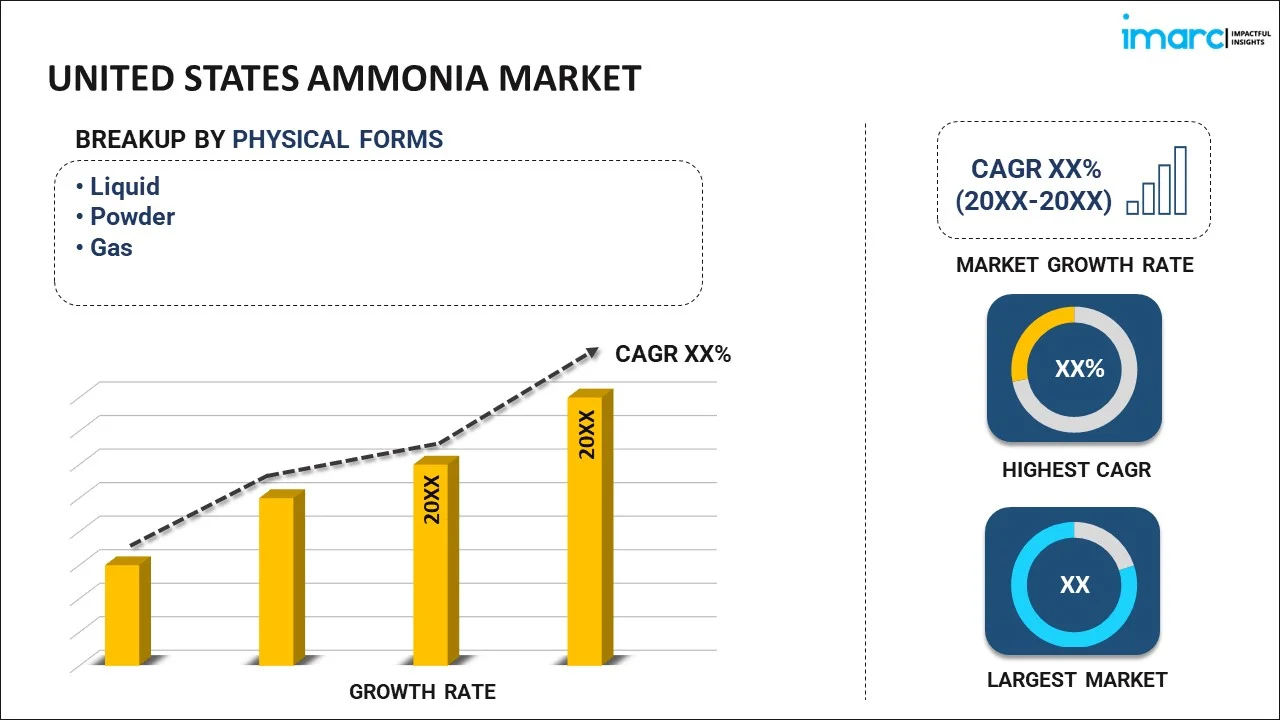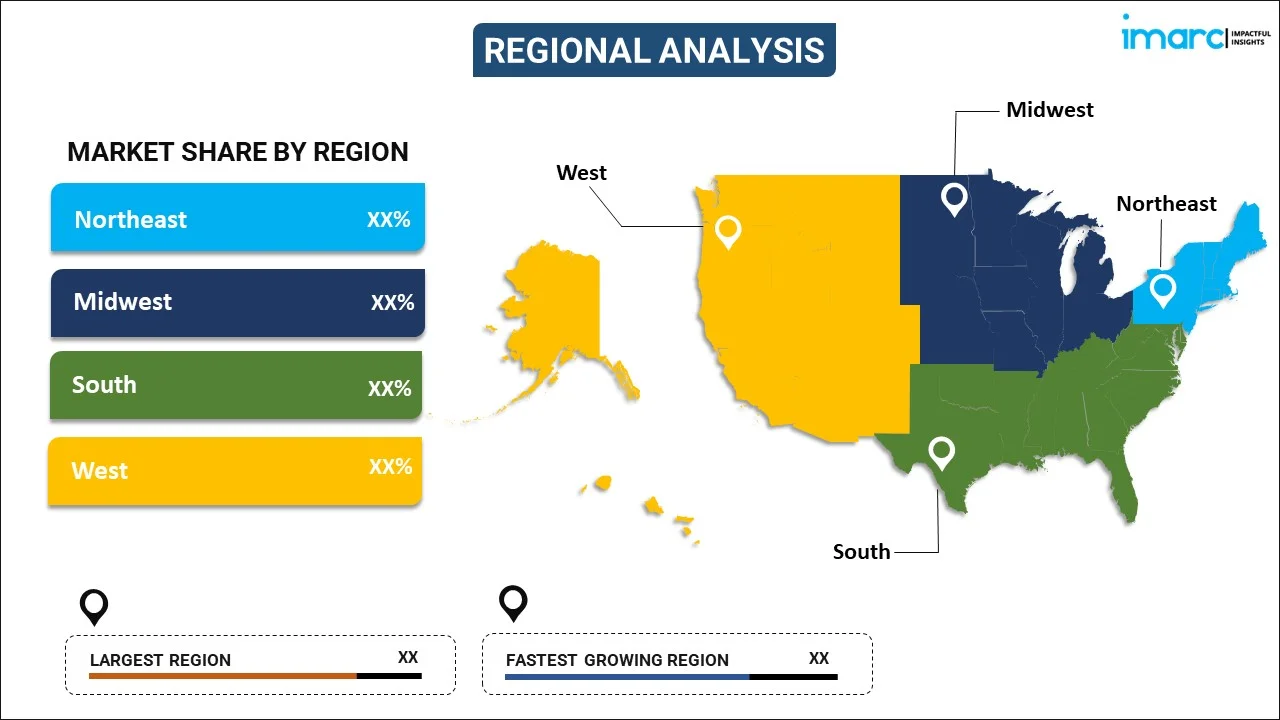
United States Ammonia Market Report by Physical Form (Liquid, Powder, Gas), Application (MAP and DAP, Urea, Nitric Acid, Ammonium Sulfate, Ammonium Nitrate, and Others), End Use Industry (Agrochemical, Industrial Chemical, Mining, Pharmaceutical, Textiles, and Others), and Region 2025-2033
Market Overview:
United States ammonia market size reached USD 20.6 Billion in 2024. Looking forward, IMARC Group expects the market to reach USD 25.3 Billion by 2033, exhibiting a growth rate (CAGR) of 2.07% during 2025-2033. The growing utilization in the agriculture sector as a key ingredient in fertilizers, rising development in logistics, including improved tank designs and safety protocols, and increasing adoption of precision agriculture techniques represent some of the key factors driving the United States ammonia market share.
|
Report Attribute
|
Key Statistics
|
|---|---|
|
Base Year
|
2024 |
|
Forecast Years
|
2025-2033
|
|
Historical Years
|
2019-2024
|
| Market Size in 2024 | USD 20.6 Billion |
| Market Forecast in 2033 | USD 25.3 Billion |
| Market Growth Rate (2025-2033) | 2.07% |
United States Ammonia Market Analysis:
- Growth Drivers: Ammonia growth is driven by strong demand for agriculture, bountiful natural gas feedstock, and improving production efficiency through technological advancements, as well as government incentives for cleaner blue and green ammonia initiatives and wider industrial uses.
- Key Market Trends: Increased adoption of blue and green ammonia, incorporation into renewable energy supply chains, increasing use of ammonia in fuel and energy storage, and investments in more sustainable production technologies are driving market development.
- Market Opportunities: Decarbonization regulations, production of low-carbon ammonia for shipping and power generation, increasing export opportunities, and carbon capture and renewable-powered manufacturing technologies provide key opportunities for market growth.
- Market Challenges: Fluctuating natural gas prices, expensive capital investment in low-carbon plants, regulatory risks, environmental factors regarding emissions, and competition from competing fertilizers and energy sources present ongoing challenges to in the United States ammonia market growth.
Ammonia is a colorless gas with a characteristic pungent, produced through the Haber-Bosch process, which synthesizes ammonia from nitrogen and hydrogen gases under high pressure and temperature in the presence of a catalyst. It comes in various forms, including anhydrous ammonia, aqueous ammonia, and ammonium salts, each offering different characteristics. It is a key component in fertilizers, providing a rich source of nitrogen, which is an essential nutrient for plant growth. It serves as a fundamental raw material in the production of various chemicals, including nitric acid, urea, and other nitrogenous fertilizers. It is a potent cleaning agent due to its ability to cut through grease and grime effectively. It is integral in the production of plastics, synthetic fibers, and other materials essential in everyday products.
United States Ammonia Market Trends:
Robust Agricultural Demand
Ammonia is a vital component of the U.S. agricultural industry as an essential ingredient for nitrogen-based fertilizers that are used to keep the soil fertile and increase crop production. The nation's large farming areas, especially the corn, wheat, and soybean farming regions, depend considerably on ammonia to maintain productivity and respond to increasing food requirements. In addition, changing farming practices like precision farming have optimized the efficiency of ammonia application, further making ammonia a more central component of contemporary farming systems. Such deep-rooted reliance guarantees a consistent market demand for ammonia along the entire agricultural value chain. Secondary applications of ammonia in water treatment and refrigeration provide additional strength to the market, though agriculture is the mainstay. Consequently, the consistent expansion of the agricultural sector remains one of the major drivers in the United States ammonia market analysis.
Low-Cost Natural Gas Feedstock and Production Efficiency
The U.S. ammonia industry is much favored by its rich natural gas resources, which are the major raw material source for traditional ammonia manufacture. Availability at low and stable natural gas prices has provided domestic manufacturers with a competitive advantage, enabling stable production volumes to be maintained and further investment in ammonia plants. Concurrently, advances in production technologies—e.g., better catalysts and process optimization—have minimized energy usage and increased efficiency generally. The technologies allow for ammonia to be manufactured at lower prices while addressing environmental and performance demands. Together, the availability of resources and technology advances have made the United States a significant producer of ammonia. Finally, the interaction between low-cost feedstock and continuous efficiency improvements in the production process continues to be the major driver and longevity in the United States ammonia market demands.
Implementation of Government Initiatives
Government policies and programs are speeding up the growth of low-carbon production of ammonia in the United States. Blue ammonia, where carbon capture technologies are used, and green ammonia, which is made with renewable energy, are becoming key to the energy transition strategy of the nation. This transition is not only cutting the carbon intensity of ammonia production but also unlocking new uses, including its deployment in clean shipping fuels, energy storage, and power generation. Private and public investments and federal incentives are pushing producers to switch to cleaner technologies and build new plants. By situating ammonia in the context of overall decarbonization, the U.S. is turning it from a mostly agricultural input into a flexible solution across various industries. Policy-driven initiatives are remodeling the market and making ammonia relevant in a low-carbon economy.
United States Ammonia Market Segmentation:
IMARC Group provides an analysis of the key trends in each segment of the market, along with forecasts at the country level for 2025-2033. Our report has categorized the market based on physical form, application, and end use industry.
Physical Form Insights:

To get more information on this market, Request Sample
- Liquid
- Powder
- Gas
The report has provided a detailed breakup and analysis of the market based on the physical form. This includes liquid, powder, and gas.
Application Insights:
- MAP and DAP
- Urea
- Nitric Acid
- Ammonium Sulfate
- Ammonium Nitrate
- Others
A detailed breakup and analysis of the market based on the application have also been provided in the report. This includes MAP and DAP, urea, nitric acid, ammonium sulfate, ammonium nitrate, and others.
End Use Industry Insights:
- Agrochemical
- Industrial Chemical
- Mining
- Pharmaceutical
- Textiles
- Others
The report has provided a detailed breakup and analysis of the market based on the end use industry. This includes agrochemical, industrial chemical, mining, pharmaceutical, textiles, and others.
Regional Insights:

- Northeast
- Midwest
- South
- West
The report has also provided a comprehensive analysis of all the major regional markets, which include Northeast, Midwest, South, and West.
Competitive Landscape:
The market research report has also provided a comprehensive analysis of the competitive landscape. Competitive analysis such as market structure, key player positioning, top winning strategies, competitive dashboard, and company evaluation quadrant has been covered in the report. Also, detailed profiles of all major companies have been provided.
Latest News and Developments:
- In May 2025, A long-term agreement was signed by Marubeni Corporation and ExxonMobil for the annual delivery of 250,000 tonnes of low-carbon ammonia from ExxonMobil's Baytown, Texas facility, which is expected to become the largest of its kind in the world. Marubeni will supply the ammonia to Kobe Power Plant in Japan and acquire an equity stake in the project. The partnership supports Japan’s decarbonization goals, boosts U.S.–Japan energy cooperation, and advances a global low‑carbon ammonia supply chain.
- In April 2025, CF Industries, JERA, and Mitsui formed a joint venture to build a $4 billion low‑carbon ammonia plant at CF’s Blue Point Complex in Louisiana. The facility, expected to start production in 2029, will produce 1.4 million metric tons annually, making it the world’s largest by capacity. CF will operate the plant, while 1PointFive will handle CO₂ sequestration. The project strengthens U.S.–Japan collaboration and advances global low‑carbon ammonia supply chains.
United States Ammonia Market Report Coverage:
| Report Features | Details |
|---|---|
| Base Year of the Analysis | 2024 |
| Historical Period | 2019-2024 |
| Forecast Period | 2025-2033 |
| Units | Billion USD |
| Scope of the Report | Exploration of Historical and Forecast Trends, Industry Catalysts and Challenges, Segment-Wise Historical and Predictive Market Assessment:
|
| Physical Forms Covered | Liquid, Powder, Gas |
| Applications Covered | MAP and DAP, Urea, Nitric Acid, Ammonium Sulfate, Ammonium Nitrate, Others |
| End Use Industries Covered | Agrochemical, Industrial Chemical, Mining, Pharmaceutical, Textiles, Others |
| Regions Covered | Northeast, Midwest, South, West |
| Customization Scope | 10% Free Customization |
|
Post-Sale Analyst Support |
10-12 Weeks |
| Delivery Format | PDF and Excel through Email (We can also provide the editable version of the report in PPT/Word format on special request) |
Key Benefits for Stakeholders:
- IMARC’s industry report offers a comprehensive quantitative analysis of various market segments, historical and current market trends, market forecasts, and dynamics of the United States ammonia market from 2019-2033.
- The research report provides the latest information on the market drivers, challenges, and opportunities in the United States ammonia market.
- Porter's five forces analysis assist stakeholders in assessing the impact of new entrants, competitive rivalry, supplier power, buyer power, and the threat of substitution. It helps stakeholders to analyze the level of competition within the United States ammonia industry and its attractiveness.
- Competitive landscape allows stakeholders to understand their competitive environment and provides an insight into the current positions of key players in the market.
Key Questions Answered in This Report
The ammonia market in the United States was valued at USD 20.6 Billion in 2024.
The United States ammonia market is projected to exhibit a CAGR of 2.07% during 2025-2033, reaching a value of USD 25.3 Billion by 2033.
The U.S. ammonia market is driven by strong agricultural demand for nitrogen-based fertilizers, abundant low-cost natural gas feedstock enabling competitive production, technological advancements improving efficiency, and rising investments in low-carbon ammonia projects. Government incentives and growing applications in energy, chemicals, and decarbonization initiatives further fuel market growth and transformation.
Need more help?
- Speak to our experienced analysts for insights on the current market scenarios.
- Include additional segments and countries to customize the report as per your requirement.
- Gain an unparalleled competitive advantage in your domain by understanding how to utilize the report and positively impacting your operations and revenue.
- For further assistance, please connect with our analysts.
 Request Customization
Request Customization
 Speak to an Analyst
Speak to an Analyst
 Request Brochure
Request Brochure
 Inquire Before Buying
Inquire Before Buying




.webp)




.webp)












